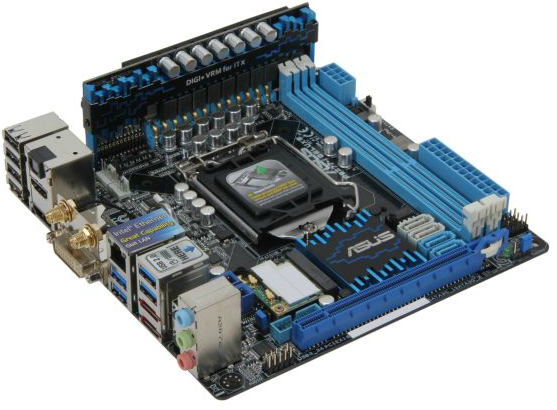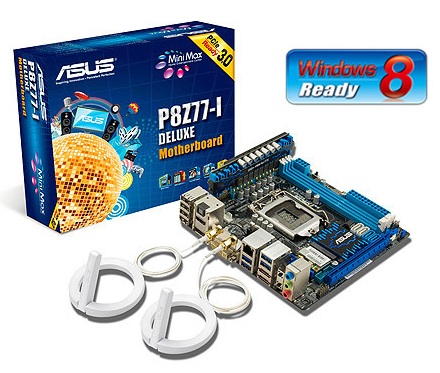Z77 mITX Round-Up: Five of the Best – MSI, Zotac, ASRock, EVGA and ASUS
by Ian Cutress on December 31, 2012 7:00 AM EST- Posted in
- Motherboards
- MSI
- ASRock
- EVGA
- ZOTAC
- Asus
- Ivy Bridge
- Z77
- mITX
ASUS P8Z77-I Deluxe Conclusion
In an industry that is losing overall sales globally and no new markets opening up, gaining market share involves taking it from your competitors. One way of doing that is by undercutting the competition, which reduces profit margins and generates a race to the bottom. The other is by innovation, but again it is hard to innovate if that occurs at great cost and there is no return in a shrinking market.
Nevertheless, ASUS has innovated. On the P8Z77-I Deluxe, the most striking feature is the motherboard layout which uses a daughter board to provide the power delivery. Using this extra z-height PCB gives extra space on the main PCB for functionality, at the downside of restricting the motherboard usage is some very-low profile cases. One of ASUS’ raison d’être is to provide a customer with something no other manufacturer can provide, and options like the TPU and USB BIOS Flashback are part of that equation.

The ASUS P8Z77-I Deluxe gives us, inter alia, a regular socket arrangement, a nicely placed 8-pin power connector, onboard WiFi (or WiDi with the corresponding model) with a pair of magnetic ring antenna, options for all four of the main video outputs, a total of eight USB ports on the IO panel (four USB 3.0), a total of six USB 3.0 ports altogether, a pair of fan headers with top-of-the-line fan controls and a pair of eSATA 3 Gbps on the back panel. This goes on top of a rock solid BIOS and software package.
There are a few issues worth mentioning, such as the positioning of the front panel audio header which will be blocked by a big GPU unless the z-height of the connector is minimal. Also there is no mSATA like on some other boards, and the SATA arrangement would require all the locking SATA cables being removed if the one at the bottom needs changing. If a GPU with a backplate is used, it could also obstruct the USB 3.0 port. On a more personal (and system debugger) note, I would have liked to see a two-digit debug as well.

Performance from the ASUS ranks among the highest, with one test pulling out a repetitive 5-20% lead over the rest. Among the gaming benchmarks it also scores very highly in the face of the competition. Power draw on our test bed was qualitatively lower, and Windows 7 POST times sat around the 11 second mark with a discrete GPU installed.
Honestly, if I were constructing a mITX build today, out of the boards tested, it would easily be with the ASUS P8Z77-I Deluxe. It comes in at $185 for the normal version and $200 for the WiDi version, which may be pricey compared to the others tested in this review, but in return we have a solid package that is easy to use and well featured. There may be a different winner if you look at price/performance in the strictest sense, but having the ASUS on the test bed and using it for my testing brought a fuller sense of ease in mITX computing.
As a result, I would like to give the ASUS P8Z77-I Deluxe an AnandTech Editors’ Choice Bronze Award, for a combined effort in motherboard innovation and as an overall package.

ASUS P8Z77-I Deluxe
AnandTech Editors’ Choice Bronze Award










54 Comments
View All Comments
Sabresiberian - Tuesday, January 1, 2013 - link
Thanks for the great comparison review!It looks like there is a little mistake in the spec list for the Asus board, which shows it having a mini-PCIe connector. I would love it if it did, but I didn't see it on the board and it isn't mentioned in other spec lists.
It is important to me because I would ideally need connection for both a graphics card and a sound card (which I believe I could do through a mini-PCIe to PCIe x1 adapter if needed). This makes the EVGA Stinger the choice for me here, though the Asus board is the one I would prefer to buy.
I am truthfully a little disappointed in the EVGA board, which seems all too common with EVGA products in general these days. Great support is still there, but I'd rather they build bleeding edge components and not have to find out whether or not their support is as good as people say it is. The Stinger is a good board to be sure, and the Intel LAN alone puts it in the category of "will buy" for me, but I was hoping it would be something that would match or beat the Asus P877-I, and it just doesn't.
Foeketijn - Tuesday, January 1, 2013 - link
When you take overclocking out of the equation, B75 has it all, for the price just a tiny bit north of the old H61 chipset. Support for IB features (1600Mhz DDR3, PCI-e 3.0), Native Sata III, USB 3.0.It wasn't intended for the DIY market but fits the bill perfectly in my opinion. Only the very very few who need to OC, +16Gb ram or multiple SSD's @ full 6 Gb/s need the Z77 chipset.
The only thing is, that us mere mortals can't predict is, if a much cheaper chipset is used, did the OEM also cheapskate on the critical parts to? I would love to see some in-depth component analysis which I see for example, when a PSU is taken apart.
Which components are used? how well is the soldering done, does it still work at a sauna lanparty, etc.
I might be alone in this, but I would find that much more valuable information than all the performance benchmarks together (race to the bottom, be dammed!).
Including the northbridge in the CPU made motherboard and CPU reviews so predictible (or borring).Since then, I'm only interested in stability, ease of installation (nicely covered) and practical use (fan controll, MEM compatibility ect).
<offtopic> Oh I loved the XP-m 2500+ siverpainting 2001 era where you actually could get a noticeable improvement of performance and not necessarily have to sacrifice stability or risk bankruptcy</offtopic>
vanwazltoff - Tuesday, January 1, 2013 - link
i picked up an asus p8z77-i deluxe/wd before christmas and made a beast gaming computer out of it with an i5-3750k OCed to 4.5ghz and a gtx670 =]vanwazltoff - Tuesday, January 1, 2013 - link
*3570kBeaver M. - Tuesday, January 1, 2013 - link
Loved the POST screen measurements and the DPC latency testing. Something you dont see every day. Actually Ive never seen it, and yet I always wanted to know those.However I am not really interested in the Z77s, since they have a horrible layout for my needs. Only the Asus one comes close to what I need, but I just dont buy Asus anymore because of several very bas experiences.
So, I wish you would also test the B75 and H77s.
paksoy - Tuesday, January 1, 2013 - link
I love the features of this Asus mobo, but i want to use it in a really small form factor case like the Antec ISK 110 VESA Case.http://www.anandtech.com/show/6192/antec-isk-110-v...
I'm just worried that the height of the VRAM board would prevent it from using it with this case.
mi1stormilst - Tuesday, January 1, 2013 - link
I still opted for the Gigabyte Z77N and love it...Sivar - Wednesday, January 2, 2013 - link
Does this refer to the ALC889 playing an audio file encoded at 192KHz?If so, does it really matter? Failing a test is never a good thing, but I know of no widely available 192KHz audio source, and such a source would have no benefit, nor would a 96KHz source.
cjs150 - Wednesday, January 2, 2013 - link
I am a happy user of the AS Rock board in a silent HTPC. It works exceptionally well. However it is clear that some work still needs to be done on motherboard design.MSata on back is excellent - now can we have it as SATA 3 because the better MSata SSDs are all Sata 3.
Placement of Sata connectors is often awkward on these boards. On edge and at right angles please.
Similarly I would love it if someone either did the 24 pin ATX power connector at right angles or someone manufactured a right angled converter that did not require de soldering the motherboard connector. Cable management in Mini-OTX is very hard and that would really help.
Finally, careful choice of RAM can eliminate issues Ian had about the closeness of the CPU socket preventing the use of many after market coolers. I use the Samsung green low profie memory, which is so low that any after market cooler can be used (and runs at 1.35v, is an unbelievably good overclocker and reasonably priced!)
romrunning - Wednesday, January 2, 2013 - link
As has been mentioned previously, the H77 chipset is great for those who do not need overclocking. I've used the Intel DH77DF, and I heartily recommend it. Since the DH77DF has an eSATA port (not too common), I've even been able to keep an eSATA dock that I used before USB 3.0 was more readily available. If you install this board into a Fractal Design Node 304 case, you can use all of the SATA ports as well. I've used it with a Silverstone SG05 case, and the loudest part of my setup is the fan on the graphics card (Radeon 7850).One thing I've noticed, though, is the relatively low mic input from the front audio. Not sure if this is common to the Realtek ALC8xx chip series, but even after boosting the gain in Win7 to +30db, it still isn't quite as loud as an older AMD board I previously had (which didn't need a boost at all).